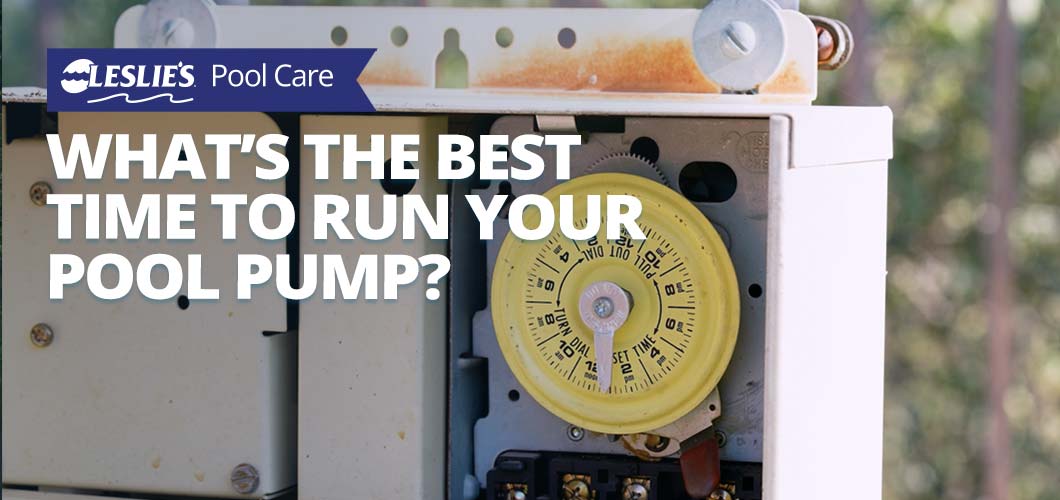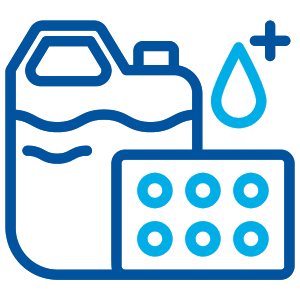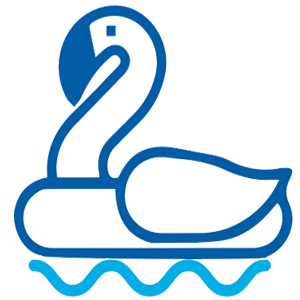
What's the Best Time to Run Your Pool Pump?
As the main source of circulation, your pool pump is responsible for keeping your pool water fresh and healthy. Without a pump, your pool would become a swampy, stagnant mess. This is why running your pump for the correct amount of time is so important. But there's another factor that plays into how effective your pump is, and that's when you run it. Today we'll discuss the best time to run your pool pump, and why certain situations call for different times.
How Long Should You Run Your Pump?
The length of time your pool pump needs to run depends on its turnover rate, which is how long the pump takes to circulate and filter all the water in your pool. On average, most single speed pool pumps should operate for at least 8 hours every day. The rule of thumb is to run your single speed pump one hour for every 10ºF of outside air temperature.
On the other hand, variable speed pumps typically need to run a bit longer than 8 hours. Most pool owners set their variable speed pump for around 12 hours of total run time. They may even take advantage of the benefits offered by both daytime and nighttime water circulation. For example, they might run the pump for 3 hours on high speed during the day to combat algae growth and swimmer contaminants during the hottest period of the day, then run the pump for 9 hours on low speed overnight. Of course, this is subject to change depending on individual pool factors. If there's a heater or salt system requiring a minimum flow rate to operate, or if your area offers lower electricity prices for "off-peak" usage, adjust the speed and timing accordingly.
BONUS TIP: Looking for a more precise approach to calculating pool pump run time? Check out our other Resource Center article!
There are certain scenarios when you may want to run the pool pump longer than you normally would. For example, periods of hot weather or increased pool usage may require you to add an extra hour or two to your pump's run time schedule. If you're having problems with cloudy pool water or algae, running the pump 24 hours a day may be necessary until the water clears up.
Thanks to the convenient automation of Intermatic pump timers or the programmable settings of a variable speed pump or digital automation center, you can set your pump to automatically run any time of day, for any length of time! Even if you're battling a pesky algae treatment and need the pump to run longer than normal, this automation can save you the hassle of manually turning the pump on and off.
Why You Should Run Your Pump During the Day
From bacteria prevention to sanitization and filtration, there are many benefits to running your pool pump during the day. While doing so may have a slightly negative impact on your energy bill, here are a few instances when it's best to run your pump in the daytime:
Algae Prevention

Water Treatment

Filtration

Algae Prevention
The dread of many pool owners, algae is a pesky pool problem that can be difficult to manage. This organic contaminant thrives in warm, stagnant water, and requires plenty of sunshine to grow. Running your pool pump during the day disrupts the still water and circulates chlorine throughout the pool — creating an inhospitable environment for algae. This is especially true in the afternoon, when temperatures — and algae activity — reach their peak.
Maintaining a regular circulation schedule and incorporating a strong algaecide into your weekly maintenance routine will turn your pool into algae's worst nightmare.
Water Treatments
Unless you're a serious night owl, most pool owners add balancing chemicals to their pool during the day. When adding any type of pool chemical, it's extremely important to run the pump. This is so the chemicals quickly incorporate into the water and disperse evenly throughout your pool. If you leave the water stagnant one of two things will happen. The chemicals will stay concentrated in one area, or they'll sink to the bottom of the pool. Both scenarios can cause serious damage and discoloration on pool surfaces, or may pose a hazard to swimmers who enter the water later. Most product labels suggest running the pump for an additional 1–4 hours (or more) after application.
If you're trying to balance the water without adequate circulation, it'll be nearly impossible to determine the actual chemistry levels of your pool. Make sure the water has plenty of time to circulate and disperse the new chemicals before retesting the water or adding more chemicals.
Filtration
As the ultimate dream team, your pool pump and filter work together to circulate and clean the pool water. After the water runs through the pump, it flows into the filter, where debris and contaminants get trapped. Clean water then travels back into your pool for you to enjoy.
Running the pump during the day — when most people are in the pool — helps the water stay clean and clear. Even the cleanest swimmers bring a certain level of debris and contaminants into the water when they swim. Operating your pump while people swim will not only help remove natural debris like leaves and dirt. It also enables your sanitizer and filter to work together to remove swimmer wastes like body oils, sweat, sunscreen, cosmetics, laundry detergent residues, hair, skin cells, and more.
Why You Should Run Your Pump at Night
It might seem like running your pump during the day is the clear winner. But there some major advantages to turning it on in the evening:
Shock Protection

Swim Time

Energy Savings

Shock Protection
Chlorine is highly sensitive to the sun's UV rays, and unstabilized chlorine degrades quickly when exposed to sunlight. In fact, the sun can break down up to 90% of unstabilized chlorine in as little as 2 hours! Cyanuric Acid (CYA) protects chlorine from sunlight, acting almost like a sunscreen for your chlorine. If your pool's CYA levels are within the ideal range of 30–50 ppm, you won't need to worry as much. Your chlorine is well protected. HOWEVER, it is easier for your chlorine to do its job during the evening hours when the sun's not out, because the chlorine is less likely to be bound to the CYA in your pool.
If you're curious why, it's because sunlight has a direct effect on the oxidation-reduction potential (ORP). What is ORP? It's a measure of the oxidizing ability of the chlorine in your pool. The ORP goes down at sunrise, when UV rays strike the pool water and cause your Free Available Chlorine to combine with CYA. The ORP goes back up at nightfall, when it's easier for the chlorine to work freely without having to break away from that CYA bond. This doesn't mean your chlorine isn't working during the day, because it most certainly is! It just has a reduced capacity for oxidation when it's in that state, and sanitization might take a little longer.
Another thing you'll have to worry about is evaporation during daylight hours. Warmer water evaporates faster, as does water in direct sunlight. And when that water evaporates, it takes your chlorine with it.
By shocking the pool and running your pump at night, you'll be helping your chlorine work as efficiently as possible for as long as possible. This also allows the chlorine plenty of time to return to normal levels, which brings us to our next point...
Swim Time
Unlike chlorine-free shock, which allows you to swim as soon as 15 minutes after application, chlorinated shock and other pool chemicals have a little longer wait time before it's safe to swim again. Fast-dissolving shock will integrate with the water quickly. However, chlorine levels will remain elevated until some amount of time has passed. And during this time, your pool is off limits to swimmers! The exact amount of wait time depends on the shock's available chlorine content, as well as the amount of shock added in relation to your pool size. The same is true for certain water-balancing chemicals, which can have a wait time of 4 hours (or more).
Shifting your water maintenance schedule to the evening hours means you won't waste valuable daylight swimming time while waiting on the chemicals to circulate. All you have to do is set your pump to run overnight, and add your chemicals in the evening. By the time the sun comes up the next day, your pool will be ready for another water test, which should hopefully show that your water is balanced, sanitized, and ready for swimming.
Energy Savings
The most popular reason for running your pool pump at night is to save money on your energy bill. Many cities in the U.S. have "on-peak" and "off-peak" energy hours, where prices fluctuate depending on energy demand. The late afternoon and evening hours are typically the least expensive time to use major household utilities, like your pool pump. Running your pool pump at night, especially if it's an energy-efficient variable speed pump, can save you a nice chunk of change.

Final Verdict
In the end, there is no right or wrong time to run your pool pump. The best plan of action is to consider the condition of your pool, the timing of your water treatments, the amount of usage during the day, and whether or not there's any money to be saved on your energy bill. When in doubt, stop into your local Leslie's and speak with one of our pool care experts. They can assist with any pool pump questions and show you the best way to care for your pool and equipment.